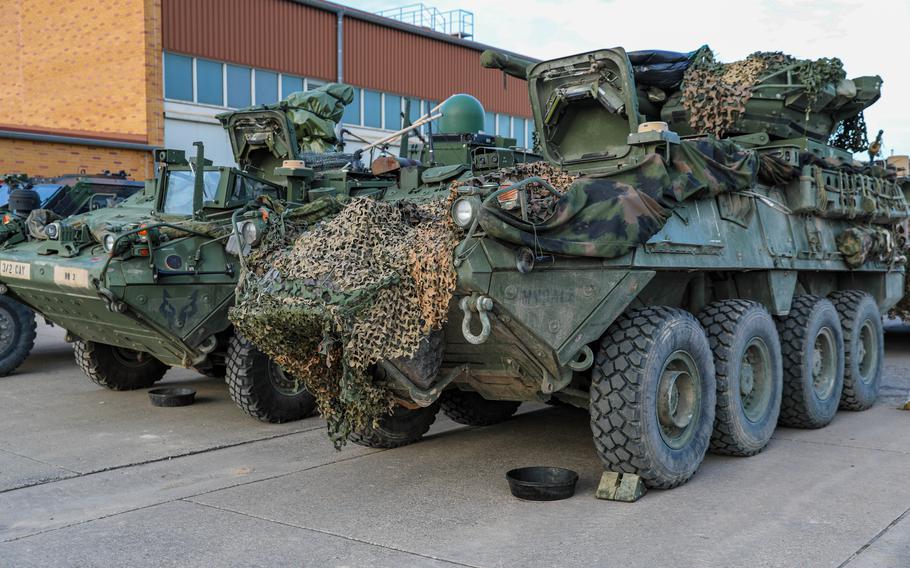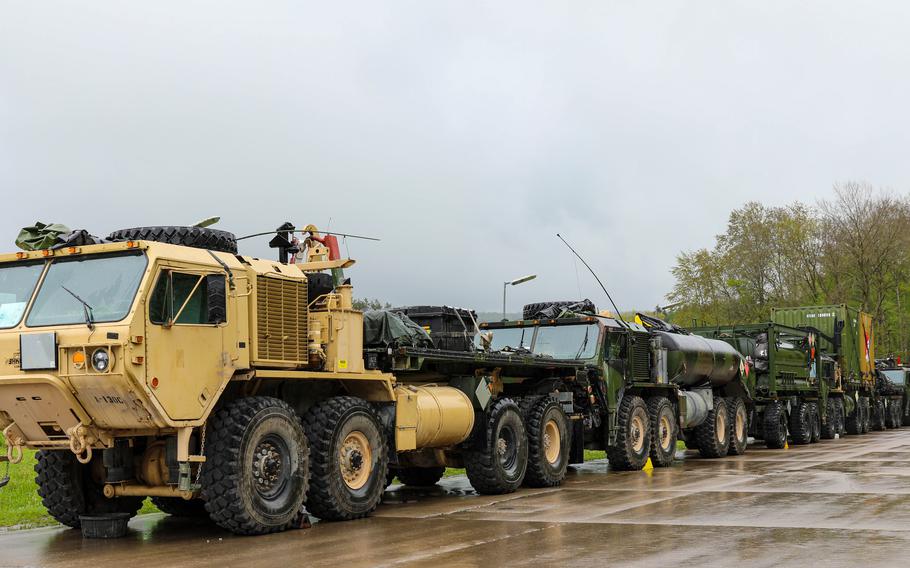
Strykers of the Vilseck, Germany-based 2nd Cavalry Regiment are prepared for exercise Griffin Shock, May 9, 2023. The exercise calls for expanding the U.S.-led force from a battalion to brigade-sized element of some 3,000 troops, V Corps said in a statement May 11, 2023. The exercise ends May 26. (Gavin K. Ching/U.S. Army)
STUTTGART, Germany — The U.S. Army this month is drilling to rapidly grow an American-led battlegroup in Poland that operates near the Russian exclave of Kaliningrad, where soldiers are tasked with defending some of NATO’s most vulnerable terrain.
The exercise, called Griffin Shock, calls for expanding the U.S.-led force from a battalion to brigade-sized element of some 3,000 troops, the Army’s V Corps said in a statement Thursday.
“Griffin Shock will validate our ability to quickly scale the NATO battlegroup in Poland into a full combat brigade under the command and control of NATO Multinational Division-Northeast,” V Corps commander Lt. Gen. John S. Kolasheski said in the statement.
The mission comes in response to a new NATO force model that allies agreed to during the alliance’s leader summit last summer in Madrid, which requires a plan to increase various eastern flank battlegroups into full brigades when needed. NATO battlegroups are made up of several hundred troops each.
In the case of Poland, the U.S. Army is the leading force in the NATO unit, which operates from Bemowo Piskie in the country’s northeast. The location is about 50 miles from Kaliningrad, where Russia maintains a sizable force. The area also is in the vicinity of the so-called Suwalki Gap, which connects Poland to Lithuania.
The small gap has long been considered one of NATO’s most vulnerable areas should a conflict with Russia ever develop. The concerns center on whether allies could mobilize fast enough should the Russian military attempt to seal off the Baltic states from the rest of the alliance.
With Griffin Shock, V Corps and NATO Multinational Corps Northeast are rehearsing how it would surge forces into that area in a crisis.

The Vilseck, Germany-based 2nd Cavalry Regiment prepares for exercise Griffin Shock, May 11, 2023. The exercise calls for expanding the U.S.-led force from a battalion to a brigade-sized element. The exercise ends May 26. (Gavin K. Ching/U.S. Army)
Units from the Army’s 4th Infantry Division, the Vilseck, Germany-based 2nd Cavalry Regiment and other Germany-based units will be part of the exercise, along with a mix of international troops.
“Through such exercises, allies demonstrate that we are a highly capable … formation that can deter and, where necessary, confront and defend potential aggressors,” Lt. Gen. Juergen-Joachim Von Sandrart, commanding general of NATO Multinational Corps-Northeast, said in a statement.
The exercise, which started on May 8, will run until May 26.